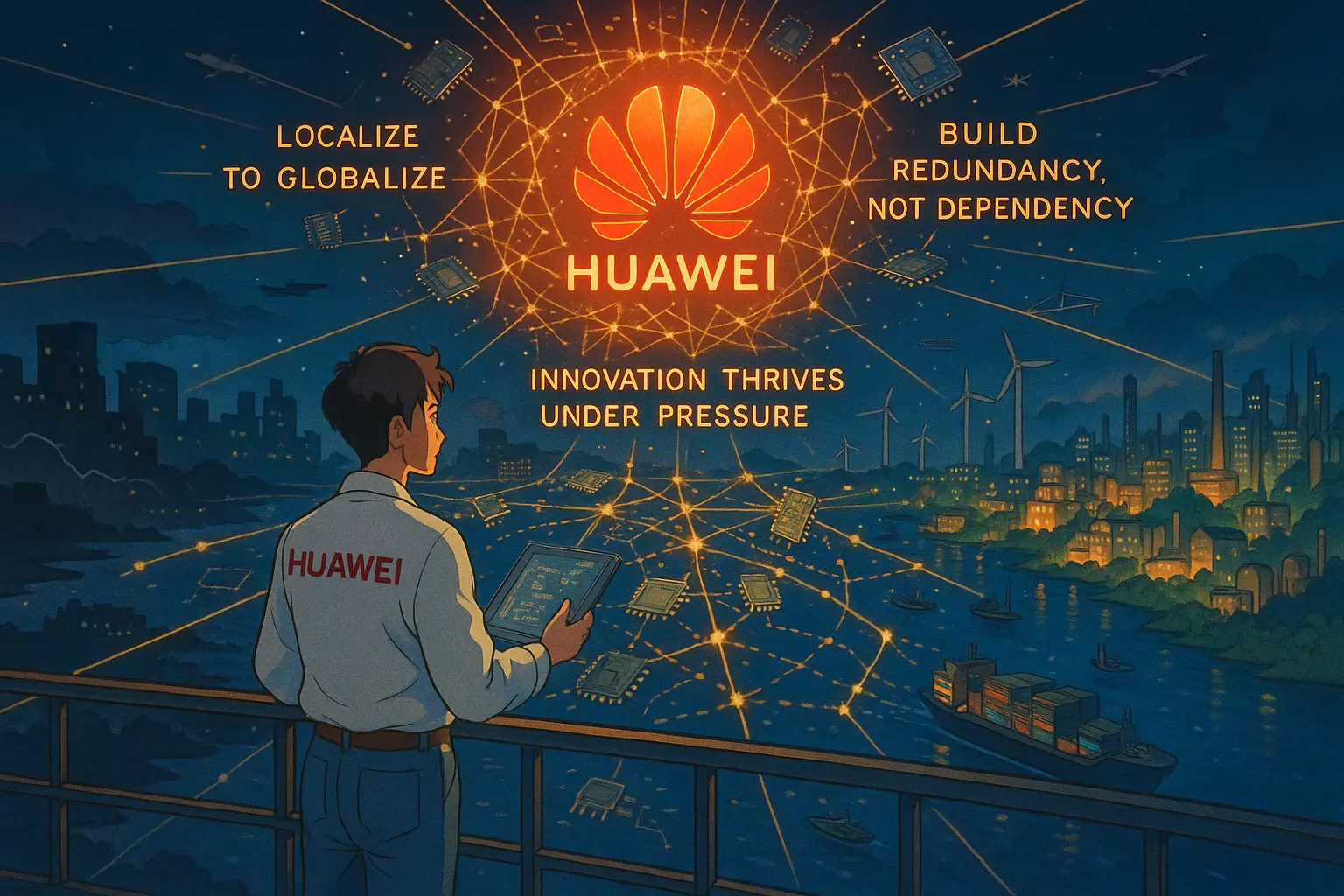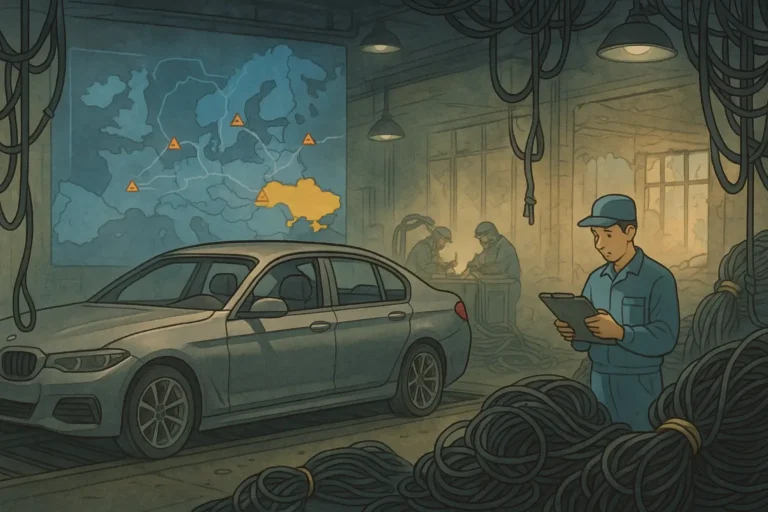
Huawei's supply chain network
Huawei’s supply chain network was one of the strongest in the world until the day it wasn’t. Many logistics and supply chain teams are familiar with the gut drop that happens when a rule change suddenly leaves operations exposed.
In Huawei’s case, it was like a cargo ship that loses its engine at sea and finishes the voyage on sails stitched from spare canvas, built under stormy skies but with grit.
Key Nuggets:
- U.S. sanctions on Huawei in 2019 cut off access to advanced chips and software services like Google’s Android.
- It broke its smartphone momentum and disrupted revenue stability.
- The sanctions on Huawei forced stockpiles, redesigns without U.S. parts, and a heavy shift into in-house R&D and new lines of business.
- Huawei’s supply chain recovery shows how design control, localized operations, and patient investment can restore output after policy shocks.
- African operators can apply these moves through regional inputs, second-source engineering, practical R&D, and anchor demand.
Supply chain resilience isn’t built in a conference room. It’s built during a crisis.
What Caused the Huawei Sanctions?
Citing national security reasons, the U.S. and many of its Western allies sanctioned and/or blacklisted Huawei in 2019.
Washington alleged that Huawei’s telecom gear could be used for spying and accused the company of violating sanctions against Iran by masking its business ties and misleading financial institutions.
Huawei was subsequently added to the U.S. Entity List, which meant American companies couldn’t sell hardware, software, or tech services to it without government permission. This wasn’t a soft nudge; it was a hard shutdown.
Before that, Huawei boasted a strong global supply chain, but overnight, that all came crashing down. The company had become a target, and some of its major suppliers were unwilling to do business with it.
Read More: How E. coli and Norovirus Exposed Chipotle’s Farm-to-Restaurant Supply.
How the Sanctions Hit Huawei’s Supply Chain Network
The impact was brutal. Huawei’s smartphone unit lost access to Google services and advanced 5G chips. This meant its phones couldn’t work like other Android devices outside China, and its telecomm operations were on shaky legs.
Global sales plummeted. By 2021, revenue had dropped nearly 30% and net profits collapsed by 69% in 2022. The company was even forced to sell its “Honor” sub-brand just to give that line a chance to survive outside the ban.
Telecom infrastructure sales held up better because the company controlled over half of China’s 5G buildout and kept contracts in markets that didn’t follow U.S. guidance. But even in that space, its access to top-tier chip design and production was blocked.
In short, Huawei’s supply chain network lost its global inputs. Without chips or software, the whole machine was at risk of grinding to a halt.
Read More: How Nike’s Lean Manufacturing Transformed Its Supply Chain.
Huawei’s Response: A Complete Rebuild Under Pressure
Time was of the essence, and Huawei moved quickly—faster than most analysts expected.
Here’s how the company adapted:
1. Stocked Up on Chips and Parts
Before the sanctions went into effect, Huawei’s supply chain spent billions buying up critical components. The company also redesigned its 5G base stations to eliminate U.S. suppliers altogether. This move gave them time to adjust while still meeting contract obligations.
2. Froze Chip Designs and Stretched Their Use
Unable to refresh its chip lineup, Huawei stuck with 7nm chips for longer than was considered normal —certainly longer than its peers. It used parallel chips and tweaked software to keep up with rivals. Design compromises increased power consumption, but did not stop product rollout.
3. Doubled Down on In-house Research
Huawei took a risk that few companies would make during a revenue drop. The company increased R&D spending to 25% of revenue. That meant over $20 billion each year went into designing chips, software, and cloud services from inside China.
By comparison, Huawei’s R&D outlay as a share of sales was significantly higher than that of Ericsson (17%), Alphabet/Google (10%), or Apple (7%).
This investment birthed the Kirin 9000S, a 7nm chip manufactured by Chinese foundry SMIC. It also led to the development of HarmonyOS, Huawei’s mobile operating system.
4. Shifted to Cloud, Energy, and Automotive Tech
Huawei didn’t stay trapped in smartphones. It moved into enterprise tech, cloud computing, solar inverters, and vehicle electronics. Its cloud business grew 20% in 2023. And its solar business became a major supplier across China and parts of Asia.
5. Leaned on China’s Home Market
Since the company was blocked abroad, Huawei leaned into China’s massive telecom market and its spending power. The country’s 5G buildout kept revenue flowing. By 2023, 60% of China’s mobile infrastructure came from Huawei.
Do you want more supply chain stories like this? Subscribe here
The Results: Huawei’s Supply Chain Finds Its Balance
Well, Huawei’s strategy worked.
In 2023, the company reported nearly $77 billion in revenue—its best year since the sanctions were imposed. Profit jumped 144% and the company also launched a new 5G phone powered by a Chinese-made chip.
The move shocked analysts who thought that wasn’t possible without Western tech.
But Huawei didn’t just bounce back in telecom. Its cloud and digital services replaced lost smartphone income. Its smartphones, though absent in the West, sold well in China.
What Huawei lost in reach, it gained in self-sufficiency.
Read More: How Dangote Refinery’s CNG Tankers Will Change Fuel Distribution.
Lessons for Supply Chain Professionals
Huawei’s story is not just about tech. It was also a stress test for global supply networks. Here are critical lessons that supply chain professionals can carry forward:
1. Don’t Build on One Source of Strength
Huawei’s business and supply chain operations, pre-sanctions, relied heavily on U.S. suppliers for chips and software. But that single point of failure nearly brought it down. The fix? Sourcing alternatives, even if they aren’t perfect.
2. Invest During The Storm
Although revenue dropped significantly, Huawei didn’t shrink its R&D; instead, it actively expanded it. Many businesses and supply chains facing similar pressures would not hesitate to cut back. Huawei used the crisis time to retool.
3. Design Around Constraints
Even when it couldn’t access the best chips, Huawei found workarounds. It built performance through clever design, not just specs. The lesson here is clear: when something’s blocked, don’t just retreat. Replan and redesign the entire supply chains.
Do you want more supply chain stories like this? Subscribe here
How African Supply Chains Can Apply These Lessons
This story about the rise and fall of Huawei’s supply chain network doesn’t just matter in Beijing or Washington. It matters in Lagos, Nairobi, Accra, and Addis Ababa.
Supply chains across Africa rely heavily on imported materials, software, and logistics capacity tied to global networks. That’s not bad, but it’s risky when those networks break. Here’s how African supply chains can turn Huawei’s story into a local strategy:
1. Build Regional Buffers
Just as Huawei stockpiled chips, African firms can start building safety buffers—whether it is through inventory, alternative sourcing, or local manufacturing agreements. Waiting until a disruption hits is too late.
2. Invest in Basic Production Skills
Huawei’s real success came from developing the talent and know-how to design and produce its own chips and systems. African supply chains can start with skills training, tooling upgrades, and small-scale production lines.
3. Treat Local Demand as the Anchor
African consumer and infrastructure markets are growing. These should become the first markets supply chains serve—not just afterthoughts to export-focused strategies.
4. Plan for Uncertainty, Not Just Smooth Sailing
Huawei didn’t assume its global supply relationships were forever. And that mindset played a significant role in the company’s survival. African supply chains need to assume things will break and then build with that in mind.
5. Encourage Partnerships, not Dependence
Instead of importing finished systems, supply chains can partner with technology firms to build under license, co-design, or customize locally. It reduces risk and builds resilience over time.

Obinabo Tochukwu Tabansi is a supply chain digital writer (Content writer & Ghostwriter) helping professionals and business owners across Africa learn from real-world supply chain wins and setbacks and apply proven strategies to their own operations. He also crafts social content for logistics and supply chain companies, turning their solutions and insights into engaging posts that drive visibility and trust.





